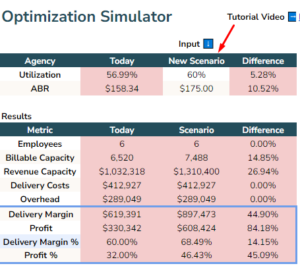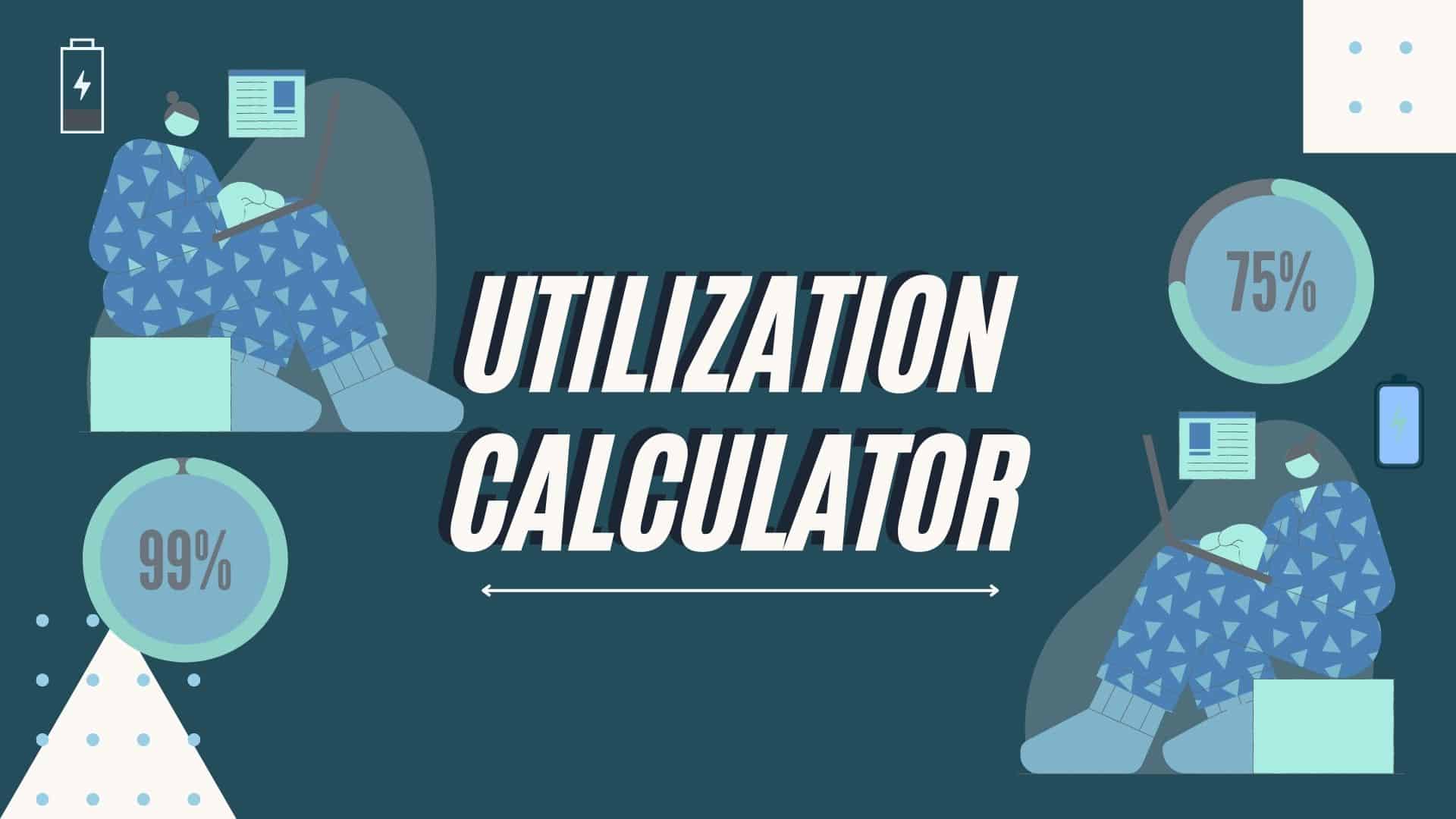You’ve found your way to this blog post, but this isn’t the first time you’ve googled how to calculate your team’s utilization rate. And you wouldn’t be here if it was crystal clear for you already, would you?
Below you’ll find the embedded calculator that keeps the utilization formula simple. It’s a way for you to calculate utilization rate of your employees in just seconds.
To get an idea of what to include/not to include in doing your utilization calculation, keep reading 👇
What Is Utilization Rate?
Utilization rate, a huge buzzword (buzz-metric?) of profitability and efficiency is basically asking yourself:
Of all of the time that I’m buying in bulk from my team, how much of it is being used to earn revenue for the business?
It’s a percentage of what time your team is spending on Revenue earning activities.
How to Calculate Utilization
Utilization can be calculated by dividing your team’s Delivery Hours by your team’s Capacity.
For example, let’s imagine we have a single employee who’s worked 100 hours in a given period of time and had 150 hours of capacity during that same time period.
In this over-simplified scenario, your Utilization rate is:
100 / 150 = 0.66
or 66%
The same formula applies whether you’re measuring a single employee, or a larger group of employees. However, the devil is in the details when it comes to this metric. The question I often get is about what exactly gets factored into or out of capacity, and what should be counted as a Delivery Hour (sometimes the same as a billable hour)
Let’s break this down a little further.
Utilization Rate Formula
The Utilization rate formula is:
Delivery Hours / Capacity
But what exactly should and shouldn’t be included in the above inputs? 👇
Defining Terminology
- Delivery Hours are the number of hours your team spent working on client work.This might be the same as a billable hour in your agency, but often a separation needs to be created between Billable Hours (for the purpose of billing) and Delivery Hours (for the purpose of measuring efficiency metrics like Utilization and Average Billable Rate)
- Capacity refers to the total number of hours that the team has during that time period (delivery work or not). An FTE for your team that works the standard 40 hours a week for a year (52 weeks) would have 2080 available hours.
**It’s important not to subtract things like vacation time, paid time off, sick days, holidays or non-delivery time from this capacity calculation, and not to exclude non-delivery team members from your capacity either. Doing so would make this metric both more complex and less accurate. If these things are being subtracted from capacity, than increases in time off or non-delivery staff would lead to an increase in Utilization (infering an increase in profitability) thereby ignoring the cost of that non-delivery and giving us the potential of a false positive signal on utilization.
These numbers can be used to calculate an individual’s rate, like in the example above, or you can do it across a subset of the business, just add up all of the Delivery Hours and Capacity numbers for those included.
For a typical team member, their Capacity is 40 hours a week, 52 weeks per year, or 2080 hours per year. You can also calculate how much this employee costs you with similar inputs at this blog post.
Interested in seeing how changes in Utilization will impact your agency’s profitability?

Agency Optimization Simulator from Parakeeto’s Agency Profit Toolkit
All of this for free, and more. Get your copy for free:
FAQs
What about time off and non-delivery time?
When calculating your total Capacity, you may be tempted to subtract things like vacation time, sick time, holidays and the weekly company foosball tournament.. While this feels like it’s a more precise way to measure capacity, it’s a lot more work, and is actually less accurate.
Subtracting out time off, holidays and even non-delivery staff from capacity calculations decreases capacity, which removes our ability to see the cost of this non-delivery time in our utilization metric. What this means is that the more time off people take, the higher our utilization will be which infers an increase in profitability. This is of course, the opposite of what this metric is intended to do and sets us up for a false positive.
For example, let’s say you’ve got a team member that works 2080 hours a year, and logs 1200 Delivery Hours. You’re looking at a Utilization of:
1200 / 2080 = 0.57, or 57%
Now consider factoring in time off. Let’s say they take a total of 30 days off per year. Convert that into an hourly number, or:
8 (hours) * 30(days) = 240 hours, and subtract it from their total Capacity (2080 – 240 = 1840). Then, let’s plug it back in:
1200 / 1840 = 0.65, or 65%
When we subtract time off from someone’s capacity, we imply that the more time off they take, the more profitable the company becomes as our utilization rate goes up. We know this is the opposite of what is true, and therefore shouldn’t change the definition to reflect this if the purpose of our Utilization metric is to measure the financial efficiency of the business.
If the objective is to measure productivity and how much available time is being spent on productive tasks – a different version of utilization should be devised and named something explicitly different. These kinds of alternative forms of utilization are popular among project managers who are more concerned with their effectiveness at allocating available time and are less concerned or accountable to controlling capacity relative to the work coming into the agency.
Why is utilization rate important?
Employee utilization calculations are a key operational metric to track for resource allocation and capacity planning. Not to mention, it can have a positive impact on your Delivery Margin if you’re able to improve it.
Resource Allocation
By getting an idea of how utilized a team member is, and where a member has too much/not enough on their plate, you’ll be able to delegate appropriately.
Capacity Planning
This also comes into play when planning for future projects, to get an idea of how much a team member can take on based on how utilized they’ve been in the past. Your utilization numbers can influence how you scope your work, and therefore create a self-tuning system for more accurate estimation.
Delivery Margin
Finally, Utilization is a key lever in moving Delivery Margin. Monitoring and optimizing your Utilization rates will have a direct impact on your Delivery Margin, and therefore overall agency profitability.
What does it mean if utilization is 100%?
If your utilization calculation is coming in at 100%, something is up. This is generally an indication of a few possible issues:
- Your team is very overworked, and are likely clocking far more hours than agreed upon in their employment contract
- Your team is inflating their timesheets to make it seem like they are more utilized than they actually are. Usually a consequence of exposing utilization to the broader team as a performance metric – which rarely results in a positive outcome.
- Your definitions for Capacity or Delivery hours are problematic and inflating your Utilization.
More on the benchmarks for industry below.
What is an ideal utilization rate?
What exactly is a ‘good’ utilization rate, and what is ‘bad’? Well, these numbers shift based on what scope you’re looking at this number through.
Agency Wide
From the agency wide lens, the industry benchmark for Utilization is 50-60% on a net annual basis. This means that, if you added up all of the Delivery Hours your team worked in a year and then added up the team’s Capacity in that year, you’re going to want to aim for 50-60%.
You might think “that seems a little low” but remember, Agency wide includes not only Delivery staff but also everyone else on the sales, admin, and marketing teams and you’re also factoring in the cost of time-off in this target.
Individual Pure Producers
So we’re looking at 50-60% as an ideal rate agency wide, but when it comes to your Pure Producers, or those at the agency that spend most of their time delivering on clients work (like a Designer or a Developer) the goal for these folks would be around 10-20% higher than agency wide, on an annual basis at 60-80% Utilization.
Finally, if you want to get an idea of benchmark rates on a weekly basis (which assumes perfect conditions with no time-off or holidays) you’ll generally add another 10-20% to the annual target.
It’s rare to see a producer with a utilization target above 95% unless they are working on the same project for months at a time with very little other responsibility.
Delivery Hours vs Billable Hours? What’s the difference?
A quick distinction we’d like to make is the difference between a Delivery Hour and a Billable Hour. A Delivery Hour, as defined above, is the number of hours you’re spending on client work. However, a Billable Hour is the number of hours you’re billing to the client.
Consider a scenario where you’ve sold a website project to a client, and they’re paying for 100 hours of your team’s time at a given hourly rate. You’re nearing the end of your hourly allowance of 100, and you haven’t quite finished the deliverable yet. After all is said and done, your team worked 120 hours to deliver the project, but you billed the client for 100. Internally, in your Utilization calculation, you’re going to use 120 (Delivery) hours to track how Utilized the team was, not 100 (Billable) hours. What you worked, and what you billed are different.
Before you Start
While Utilization can be a great operational metric to keep an eye on, there are a couple of common mistakes that agency owners make when using it. Let’s learn from there mistakes by following some general guidelines around it:
Most importantly, Utilization tracking shouldn’t really be exposed to the team where you’re holding someone accountable to a higher rate. This kind of interaction could easily lead to inflated timesheets, or deliberate overservicing clients to meet Utilization goals.
Ultimately, Utilization is a metric that owners and leadership at the agency are responsible for managing. Utilization rates are determined by how much capacity the agency has vs how much work it brings in compared to that capacity. Only the people in the organization that can influence hiring decisions and new business should be accountable to utilization. Most of the delivery team won’t have any influence on how much work comes into the business, and whether or not the team is over or under-staffed at a given moment in time.
Keep this in mind, use this as a constructive metric to optimize you and your agency, and you’ll be fine out there.








0 Comments